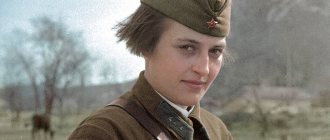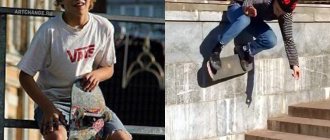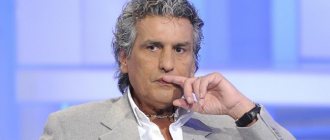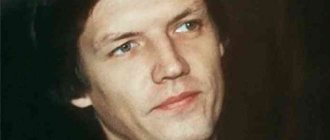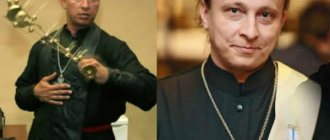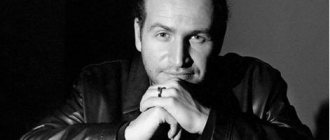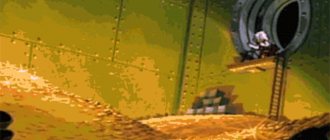Biography
Antonio Luciano Vivaldi is an Italian composer, conductor, teacher, virtuoso violinist, author of 500 concerts for solo instruments and orchestra, 90 operas, a genius whose works were forgotten for 200 years.
Antonio was born on March 4, 1678 in Venice in the family of barber and musician Giovanni Battista Vivaldi and his wife Camilla. Giovanni was originally from Brescia, and at the age of 10 he settled in Venice with his mother. In those days, barbers shaved, cut, curled and anointed their clients, and also entertained them by playing music.
Antonio Vivaldi in his youth
Vivaldi Sr. combined hairdressing with playing the violin. Giovanni became a violinist in the chapel of St. Mark's Cathedral, and his name appears on the list of founders of the musical society and even on the title page of one opera dated 1689.
The director of the mentioned society was the composer and author of operas Giovanni Legrenzi. Based on these facts, the compilers of Vivaldi’s biography came to the conclusion that the composer owes his talent and first steps in the musical field to his father, who instilled in his son a love for the violin and passed on his own skills, perfect pitch and mastery of the game. There is also a version that young Antonio studied with Giovanni Legrenzi.
The circumstances of the birth of Vivaldi Jr. made it possible to find out the exact date of his birth. The fact is that the boy was born premature, in the seventh month. The midwife who delivered the baby advised the child to be baptized immediately in case of sudden death. A couple of hours after the birth, the baby was already baptized, as evidenced by the entry in the church book.
Church of St. John in Bragor, where Antonio Vivaldi was baptized in 1678
According to legend, on that day there was an earthquake in Venice, and the child was born prematurely. Camilla allegedly vowed to give her son to the clergy if he survived. Surprisingly, Antonio survived, although he had poor health and a slight build.
Due to asthma, it was difficult for the boy to move, and wind instruments were also banned. But the violin, beloved since infancy, was at the complete disposal of the future maestro, and from the age of 10 Antonio replaced his father, playing in the Chapel of St. Mark.
St. Mark's Cathedral in Venice
From the age of 13, Vivaldi Jr. served as the “goalkeeper” at the cathedral, opening the gates of the temple. Then several more initiations of the young church minister to higher positions took place. Antonio served Mass only once; he was given an exemption due to poor health, and the young man was given the opportunity to devote himself to music.
In those days, Venetian priests combined writing concerts and sacred music with serving God. This was considered as natural as the presence of musical instruments in every barber shop. In the 17th century, the Republic of Venice was one of the most enlightened and cultural countries in the world, and in the field of opera, secular and sacred music, it set the tone for the rest of Europe.
Antonio Vivaldi - an outstanding composer and performer of the Baroque era
Details Category: European classical music of the 17th-18th centuries Published 12/14/2018 18:21
The works of Antonio Vivaldi are popular all over the world. But it was not always so.
During his lifetime (during the first half of the 18th century), the composer was widely known; he was known as the creator of the solo instrumental concert. Contemporaries called him “a great, unsurpassed, delightful writer.” Vivaldi's concertos served as a model even for composers such as J.S. Bach, P. Locatelli, D. Tartini, J.-M. Leclerc and others. In the era of musical baroque, these were famous names. Bach even arranged 6 violin concertos by Vivaldi for the clavier, made organ concertos from 2 of them, and rearranged one for 4 claviers - he was so admired by his clarity and harmony of harmony, perfect violin technique, and melody by Vivaldi’s music.
Alleged portrait of Vivaldi But some time passed, and Vivaldi was almost forgotten. His works cease to be performed, even the features of his appearance are soon forgotten: to this day his portraits are considered only supposedly to belong to him. And only in the middle of the 20th century. interest suddenly arose in his work, including his biography, about which little is known. What was the reason for this renewed interest? Apparently, real art, even temporarily forgotten, cannot lie hidden for long - gold will still shine. But perhaps Vivaldi was simply ahead of his time, and after his death his contemporaries could not accept his music at his level. The Austrian scientist Walter Collender argued exactly this: Vivaldi was several decades ahead of the development of European music in the use of dynamics and purely technical techniques of violin playing. Thus, today his art has received a second life.
Vanessa May, a British violinist of Chinese-Thai origin, masterfully performs Vivaldi's works in a modern arrangement
Music
At the age of 25, Vivaldi began teaching the art of violin playing at the Ospedale della Pietà in Venice. Conservatories were then called shelter schools at monasteries, where orphans and children whose parents were unable to provide for them were educated. These schools were financed from the republic's funds.
Conservatory "Pieta" in Venice
The girls' shelters specialized in the humanities, with special attention paid to singing, music, and the performance of spiritual melodies, psalms and chants. The boys, who were trained as traders and artisans, were taught exact sciences.
Antonio Vivaldi became a violin master for the young pupils of the orphanage, and then a viola teacher. His duties included monthly writing of concerts, cantatas, vocal works for soloists and choir, as well as the creation of new oratorios and concerts for each church holiday. In addition, the teacher personally taught the orphans music, playing instruments and vocals, rehearsed and honed the girls’ skills.
Vivaldi worked at Pietà from 1703 to 1740, not counting an eight-year break from 1715 to 1723, and from 1713 became director of the conservatory. All these years, the composer worked tirelessly; he wrote more than 60 works for the shelter alone, including cantatas, concerts for solo, choral, and orchestral performances.
In 1705 and 1709, Venetian publishing houses published two Vivaldi opuses of 12 sonatas, and in 1711 - 12 concertos under the title “Harmonic Inspiration”. In those same years, the young and talented composer was heard for the first time outside of Italy. In 1706, Vivaldi performed at the French embassy, and three years later his oratorio was heard by the Danish king Frederick IV, to whom Antonio subsequently dedicated 12 sonatas.
In 1712, the musician met the German composer Gottfried Stölzel, and five years later Vivaldi moved to Mantua for three years at the invitation of Prince Philip of Hesse-Darmstadt.
Antonio Vivaldi
Since 1713, the composer became interested in a new form of musical art - secular opera. The first opera written by Vivaldi was Ottone at the Villa. The talented young man was noticed by impresarios and patrons of the arts, and soon Antonio received an order from the owner of the San Angelo Theater for a new opera.
According to the composer, in the period from 1713 to 1737 he wrote 94 operas, but only 50 scores with confirmed authorship of the great Vivaldi have survived to this day. The author of the operas enjoyed stunning success, but Vivaldi's secular fame was short-lived. The musically sophisticated Venetian public soon found new idols, and Antonio's operas went out of fashion.
In 1721, the maestro visited Milan, where he presented the drama Sylvia, and the next year he returned with an oratorio on a biblical theme. From 1722 to 1725, Vivaldi lived in Rome, where he wrote new operas and performed before the pope at a personal invitation. For the musician-clergyman this event was a great honor.
In 1723-1724, Vivaldi wrote the famous concertos, erroneously called “The Seasons” in the CIS (the correct name is “The Four Seasons”). Each of the violin concertos is dedicated to spring, winter, summer and autumn. According to most critics and researchers, these concerts are the pinnacle of the maestro’s creativity.
The revolutionary nature of works of genius lies in the fact that the human ear clearly catches in music the reflection of processes and phenomena characteristic of a particular season. So, in the song of the violin you can hear the noise of a storm and the barking of dogs, the squeaking of mosquitoes and the bubbling of streams, children's voices, the trills of birds of recognizable breeds, and even the fall of a skater on the ice.
Austrian Emperor Charles VI
Tours and travels led the maestro to meet the Austrian Emperor Charles VI. The king was a big fan of Vivaldi's work, and friendly relations began between them. Surprisingly, as the popularity of the composer’s music declined in his homeland, Venice, his fame grew in Europe, at the courts of the French and Austrian kings.
At the end of his life, luck abandoned the brilliant composer, and he was forced to sell his sonatas for pennies, just so as not to vegetate in poverty. Disillusioned with the Venetians, who stopped loving his creations, Antonio Vivaldi decided to move to Vienna, “under the wing” of the royal admirer of his talent, Charles VI.
Unfortunately, soon after the composer moved to Vienna, the emperor died, then the war began, and the maestro was forgotten.
Antonio Vivaldi
Antonio Vivaldi is a famous Italian composer, violinist, talented conductor and teacher. On March 4, 1678, seven-month-old Antonio Lucio Vivaldi was born into the family of Giovanni Battista Vivaldi in Venice.
. After Antonio, two more sons and three daughters were born into the family, however, none of them became a musician. Antonio received his first music lessons from his father, a violinist in the orchestra of the Cathedral of San Marco. His amazing musical talent manifested itself very early. At the age of ten, Antonio often replaced his father in the orchestra. According to some sources, Vivaldi received composition lessons from the famous G. Legrenzi. He created his first musical composition in 1691. At the age of fifteen, Antonio decides to become a priest. On September 18, 1693, he received tonsure and was appointed “goalkeeper” - the servant who opens the gates of the temple. Having accepted three lower and two more higher degrees of the priesthood, in 1700 Vivaldi became a deacon, three years later he received the title of priest, which gave him the right to serve mass. Music was still his main hobby. In the early 1700s, he studied with the famous Italian violinist and composer Arcangelo Corelli.
Having received the title of priest, in September 1703 Vivaldi was invited to give violin lessons at one of the best conservatories in Venice - the Ospedale della Pietà.
Brilliant opportunities opened up for Vivaldi to realize his creative ideas. For his students he creates oratorios, cantatas, sonatas, concerts, and works of other genres. In 1706, his first brilliant public appearance took place. At the same time, he trains choristers, conducts an orchestra, is a concert director, and teaches music theory. Vivaldi pays special attention to instrumental music. For the first time, Vivaldi appears before the musical community of Venice as the author of trio sonatas. In 1705, 12 of his sonatas were published under opus 1. The second opus was published in 1709, it included 12 sonatas for violin accompanied by cymbal. There are 78 known works written by Vivaldi in the genre of sonatas for violin or several instruments. In 1711, Vivaldi was given a fixed annual salary, and in 1713 he became the chief composer of the Pietà Women's Conservatory.
Vivaldi's fame extends beyond his native Venice; his works are published outside of Italy. In 1712, his famous 12 concertos, written for one, two and four violins, were published in Amsterdam. During the same period, the composer began to write operas and took an active part in their production. The Diversion at the Villa was his first opera, staged in 1713. The second opera, Roland Pretending to be Mad, was followed by several more successful premieres, which brought Vivaldi fame as an opera composer.
In 1720, Vivaldi is in the service of Margrave Philip von Hesse-Darmstadt in Mantua. Here Vivaldi meets the opera singer A. Giraud and her sister Paolina.
Anna and Paolina became constant faithful companions of the famous composer on his many travels. The close connection with the Giraud sisters caused discontent among the clergy, who saw this as a deviation from the norms of priestly behavior. Despite these attacks, Vivaldi treated his companions with deep respect and always defended their honor and dignity. After three years of service in Mantua, the composer returned to Venice. In 1725, the composer’s cycle entitled “The Art of Harmony and Invention” was published, which included his famous “Seasons” concerts. In total, 28 instrumental program works by the composer are known. The composer's creative versatility and productivity are amazing. In 1735, “Adelaide” and “Tamerlane” were performed in Verona; in 1736, “Ginevra, Princess of Scots” was performed with stunning success in Florence.
However, on November 16, 1737, the composer was banned from entering Ferrara on behalf of Cardinal Ruffo,
which meant discrediting the composer as a clergyman. The main reason for this was his relationship with Anna Giraud. At the end of 1740, the composer left Venice forever and moved to Vienna. The works of the great composer during this period were not noted for their former enormous popularity. The forgotten and ill great composer Antonio Vivaldi died on July 28, 1741. A little time will pass and the music of the great composer will make his grateful descendants gasp with delight.
Personal life
As a clergyman, Antonio Vivaldi took a vow of celibacy, which he observed throughout his life. And yet, ill-wishers were able to discern a violation of decency in his close relationship with one of the pupils of the Pietà Conservatory, Anna Giraud and her sister Paolina.
Vivaldi was the teacher and mentor of Anna, who, according to the recollections of contemporaries, attracted the attention of the public not with the strength and range of her voice, but with her acting talent. For this girl, the composer wrote the best operas, composed arias and spent time together at home and on the road.
Anna's sister, Paolina, idolized the maestro and became a volunteer nurse and caregiver with him, helping to cope with congenital ailments and bodily weakness. For a long time, the higher clergy turned a blind eye to the maestro’s passion for secular music and operas, but they could not forgive him for constantly being around two young girls.
In 1738, the Cardinal Archbishop of Ferrara, where the next carnival with the same operas was supposed to take place, did not allow Vivaldi and his companions into the city, and also ordered a mass to be celebrated in view of the composer’s fall from grace.
The meaning of the word Vivaldi
Examples of the use of the word Vivaldi in literature.
Adamovich Georgy - 190,191,194, 291,308 Andropov Yuri - 127,128 Annensky Innokenty - 295, 314 Anrep Boris - 247 Akhmatova Anna - 7,10,13,14,30, 36,43,45,47,50,56-59,93,100, 1 01,106,108,109,138,142 -144, 157,161,181,190,192,204,206, 213-215,218,223-228,230-256, 261-278,289,295,310,312-314, 317 Bagritsky Eduard - 308 Byron George - 5,51,96,138 -140,149,152,233,272 Bakst Leon - 173 Balanchine George - 189,190,193,196,197,291,292 Baratynsky Evgeniy - 52,56,173,227-230 Baryshnikov Mikhail - 177,179-181,184,214,283,296,297,302-305,307 Batyushkov Konstantin - 51 Bach Johann Sebastian - 100, 204,213,240,241,263 Bakhtin Mikhail - 174,290 Beckett Samuel - 14.1 35 Bely Andrey - 150,289 Benkendorf Alexander - 107 Berdyaev Nikolay - 49,191 Beria Lavrentiy - 55 Berkovsky Naum - 230 Berlin Isaiah - 173,181,247,248,266,269 Burns Robert - 34 Berryman John - 145 Beethoven Ludwig van - 44 Bitov Andrey - 287 Bleriot Louis - 246 Blok Alexander - 22,50,155,227,228,233,240,251,274,275,277,288,295 ,301,314 Bobyshev Dmitry - 226,227,232 Baudelaire Charles-Vivaldi, Gluck, Haydn, Vitali, Mozart,
Bottesini, Saint- Sanz, Bizet-Born, Wieniawski, Tchaikovsky, Granados, I.
Bogdan would not mind talking to her after the concerto and discussing the delights of Vivaldi.
At the same time, Vivaldi's abacus was made of gold wires, along which crystals of rubies, emeralds, onyxes and black agates, polished in the shape of prisms, adjacent to each other, moved.
In the program: Corelli, Tartini, Vivaldi RZK Concert of choral music Conductors - assistant trainees of the department of choral conducting Concert Hall.
The silver woman played Vivaldi on an electric piano, and the silver man sang a futuristic melody in his voice to the accompaniment.
In any case, Vivaldi's relations with clerical circles continued to strain, and soon he, citing his poor health, publicly refused to celebrate Mass.
Vivaldi's violin concertos very soon became widely known in Western Europe and especially in Germany.
Apparently, Vivaldi was not satisfied with the income from the publication of his concerts, and in 1733
In fact, since then, no new original works by Vivaldi have appeared.
In our country, Vivaldi is one of the most frequently performed and most beloved composers.
Many of Vivaldi's instrumental works have programmatic subtitles.
Already during his lifetime, Vivaldi became famous as an outstanding expert on the orchestra, the inventor of many coloristic effects, and he did a lot to develop the technique of playing the violin.
Who knows, maybe he enjoys listening to Vivaldi and even reading Dickens?
Dickens and Vivaldi,” she whispered, “Come back to me, Michael, I beg you.”
Source: Maxim Moshkov library
Death
The brilliant composer died in poverty and loneliness in a foreign land, in Vienna. Antonio Vivaldi's life was cut short on July 28, 1741. His property was described and sold for debts, and his body was buried in a cemetery for the city's poor. Only a month after Antonio's death, his younger sisters received sad news.
Sculptural composition in Vienna dedicated to Antonio Vivaldi
After his death, the name of Vivaldi was undeservedly forgotten. Perhaps only Johann Sebastian Bach sincerely and deeply loved the Italian’s music, remaining for a long time his only faithful admirer. Bach transcribed ten Vivaldi concertos for various instruments and orchestra, and the legacy of the Venetian composer had a tangible influence on the work of the virtuoso organist.
Interesting Facts
- Much credit for the research and discovery of Vivaldi's masterpieces for posterity belongs to the Italian musicologist Alberto Gentili, who discovered 14 volumes of the composer's works at the beginning of the 20th century.
- Antonio Vivaldi is the first composer to create concertos for violin and orchestra, two, four violins and two mandolins.
- The only color portrait of Vivaldi, which is familiar to everyone from photographs in textbooks, may well be the image of a completely different person (the initials are not indicated in the picture, and the portrait itself is not similar to other portraits of the composer).
Famous color portrait of Antonio Vivaldi
- The maestro had the nickname “red priest” because of his copper hair color, rare among Venetians.
- Vivaldi also became famous for the fact that he could write a three-act opera and dozens of musical variations on one theme in five days.
- The notorious "Tango of Death", attributed to Vivaldi, is actually a composition called Palladio by modern composer Karl Jenkins, and "Elven Night (Song)" is a song by Secret Garden.
- The composition “Summer Thunderstorm (Storm)” from the “Seasons” series performed by Vanessa Mae is one of the most popular melodies in the world.
Vivaldi A.
(Vivaldi) Antonio (4 III 1678 (?) Venice - 28 VII 1741, Vienna) - Italian. composer, violinist, conductor and teacher. He studied with his father Giovanni Battista V., violinist of the chapel of the Cathedral of St. Mark in Venice and, apparently, from G. Legrenzi. He became famous early on for his virtuoso violin playing. From 1703 he was a teacher (maestro di violino), later an orchestra conductor and director of concerts, and from 1713 also a director of women. Conservatory “Pieta” (“Ospedale della Pieta”). V.’s duties included composing music for numerous groups. secular and spiritual concerts of this conservatory. V. connected the profession of a musician with the clergy of a minor abbot, but then he was removed from the rank of clergyman for “illegal” behavior during a church service. V. participated in the theater. life in Venice, devoting a lot of energy to staging his own operas (he rehearsed with troupes, conducted performances, and often acted as an impresario). The noisy and festive life of Venice, carnivals and masquerades, the brilliance of the theater. performances and rich urban song folklore left a deep mark on V.'s work. In 1718-22 V. served at the court in Mantua. In subsequent years he performed concerts in Italy and other European countries. In 1725 he was removed from work at the conservatory, and in 1735 he was reinstated as bandmaster. Soon, as a result of clashes with clerical circles, V. left Venice and moved to Vienna, where he spent the last years of his life. Despite his wide popularity, V. died in poverty.
V. became famous as a conductor, violinist, teacher and composer. Under his hand. concerts of the orchestra “Della Pieta” conquered Europe. fame. I was especially struck by the new “Lombard” (dramatized) style of playing and V.’s virtuosity. The spread of V.’s playing style among Europeans. Violinists were encouraged by the popularity of his violin concertos, which were unusual for that time in form and texture. V. did not leave behind a “school” like A. Corelli and G. Tartini (among his students who gained fame can only be named G. Somis and L. Madonis), but he had a versatile pedagogy. talent, studied with singers, including F. Bordogni.
V.’s creative heritage is great. The composer created 465 instruments. concerts. He also wrote oratorios, secular cantatas, and religious music. V.'s operatic work (over 40 operas, many on historical and mythological subjects; libr. by P. Metastasio, F. Silvani, D. Lalli, A. Zeno, etc.) contributed to the development of the opera genre and influenced many composers (including G. F. Handel), but was not appreciated by his contemporaries. In instr. prod. of the early period (trio sonatas op. 1, etc.), despite the strong influence of A. Corelli, an original creativity is already evident. the composer's style (especially in sharply defined initial themes). From the very beginning, V. ignores the church. genre and writes only in the chamber style (his sonatas are nothing more than suites). Trio sonatas, from the point of view of violin technique, are quite modest. Adjacent to them (in terms of the general melodic style and technical use of the violin) are 2 collections of solo sonatas for violin and bass (Op. 2 and Op. 5), in which the sonata form is freely interpreted - a significant milestone in the development of sonata allegro. Historical the significance of V.’s creativity is in the creation of a solo instrument. concerto: the composer, as it were, summed up the long process (from the beginning of the 17th century to the mid-18th century) of the continuous growth of concert elements in violin art. Based on the concerto grosso of the founder of the new instrument. Corelli's music, V. did mean. a step forward compared to its predecessor in terms of the scale of development, diversity of means of expression, dynamism and expressiveness of the music. Preclassical solo instrument V.'s concert is an ensemble piece for a small ensemble of stringed instruments led by a violin (this is the most typical composition, although many of V.'s solo concertos have been written for a wide variety of instruments: cello, viol damour, mandolin, flute, oboe, bassoon, trumpet and etc.). Established V. dynamic 3-part cyclic. the form of the concert (a fast, energetic first movement and a brilliant, lively finale, framing a small, melodious middle movement) expressed artistry. the ideals of art are “well-organized contrast.” Solo instrumental V.'s concert was designed for a wider audience than Corelli's solo sonata: this music. the form is characterized by elements of “spectacle”, revealed in the competition between the soloist and the orchestra (in the words of B.V. Asafiev, there was something of theater and discussion in it). In the constant alternation of tutti and solo, whole and part (the ritornello found its unique refraction in this), the meaning of the concert form is revealed and, at the same time, a play with sound masses and sound chiaroscuro is created. V. was a great master of these Rembrandt techniques in music. In music The content of V.'s concerts embodies features characteristic of the “late baroque.” His concerts are impressive, on the one hand, with monumentality and pathos (especially in the first movements), and on the other, with the soft lyrics of the slow middle movements.
A. Vivaldi. Fragment from the violin concerto in d minor. Autograph.
Most of his adagios are of the lyrical variety. arias, where the focus of the listener’s attention is a virtuoso expressing his own. individuality, like a singer at the climax. moments of the opera. B.'s music absorbed elements of colorful Venetian music. folklore, rich in melodious canzonas, barcarolles, and incendiary dances. rhythms—hence the concreteness and figurativeness of the thematic nature of his concerts. Widespread among V., favorite in Italy. adv. music size 6/8 (size of plural Italian folk dances). Dance is interpreted especially diversely. form of siciliana. At the same time, in concerts V. creatively reworked the stylistic style. Features of monumental and decorative art of the Venetian voc.-instrument. polyphonic school, with its “cori spezzati” system. Often using chord-harmonic. warehouse, he masterfully used polyphonic. linear style of writing, willingly resorted to contrapuntal. forms, which were put forward by the muses. Renaissance 16-17 centuries One of the largest masters of tools. fugue (its perfect example is the 1st part of the concert in d minor, op. III, No. 11), V. influenced the formation of the work of J. S. Bach, anticipated the grandiose art of the German fugue. composer. V.'s concerts expanded expressive and technical. means of violin and instruments ensemble. Their violin technique is varied: it is fast. passages, arpeggios, tremolo, pizzicato, double notes (up to the most difficult tenth stretches), flautato playing effects, scordatura, use of the highest register (up to 12th position). By this V. contributed to the development of colorism. sides of violin playing. V. can be called the father of program symphonism. There is no music equal to his 4-part cycle “The Seasons” op.VIII, No. 1-4 (“Quattro Staggione”, for main violin - violino principale, string quintet, organ and cymbal). art up to the “Pastoral Symphony” by L. Beethoven. V. appears in this production. not as an imitator of nature, but as a great realist expressing his lyricism. perception of the surrounding world. Programmatic in design and much more. V. concerts: “The Hunt” (“La Caccia”, op. VIII, No. 9, 10), “Storm at Sea” (“La Tempesta di Mare”, op. VIII, No. 5, op. X, No. 1) , “Shepherdess” (“La Pastorella”), “Anxiety” (“L’Inquietudine”), “Rest” (“Il Riposo”), “Night” (“La Notte”, op. X, No 2), “ Favorite" (“Il Favorito” op. XI, No. 2), “The Goldfinch” (“Il Cardellino”, op. X, No. 3), etc. Concerto “Night” for bassoon or flute, bow ensemble and cymbal, distinguished by the finest sound writing, replete with bold colors. and harmonious finds.
V.'s contribution to the development of instrumentation is significant. He used oboes, horns, bassoons, trumpets, English. the horn not as duplicating voices, but as independent ones. melodic tools. Instr. V.'s concert opened the way for a new classical music. symphonies.
V.'s work, which towards the end of the composer's life was criticized by his contemporaries (B. Marcello, C. Goldoni, I. Quantz, etc.), was forgotten after his death. The revival of interest in V.'s music is associated with the discovery in the end. 20s 20th century Italian musicologist A. Gentili of V.'s manuscripts (300 concerts, 19 operas, sacred and secular vocal works). The Italian Institute of Antonio Vivaldi, founded in Siena, headed by F. Malipiero, began the publication of the complete collection. works by V. So. contributions to the study of V.'s creativity were made by the French. musicologist M. Pencherl and German. - V. Kolneder.
Works : operas (27), including Roland - the imaginary madman (Orlando fiato pozzo, 1714, Sant'Angelo, Venice), Nero who became Caesar (Nerone fatto Cesare, 1715, ibid.), Coronation Daria (L'incoronazione di Daria, 1716, ibid.), Deception triumphant in love (L'inganno trionfante in amore, 1725, ibid.), Farnace (1727, ibid., later also under the name Farnace, ruler of Pontus) , Cunegonde (1727, ibid.), Olympias (1734, ibid.), Griselda (1735, t-r. "San Samuele" Venice), Aristides (1735, ibid.), Oracle in Messenia (1738, t-r. " Sant'Angelo", Venice), Theraspes (1739, ibid.); oratorios - Moses, God of the Pharaoh (Moyses Deus Pharaonis, 1714), Triumphant Judith (Juditha Triumphans devicta Holofernis barbarie, 1716), Adoration of the Magi (L'Adorazione delli tre Re Magi, 1722); secular cantatas (56), including 37 for voice with basso continuo, 14 for voice with strings. orchestra, large cantata Gloria and Hymen (1725); serenades for 1-4 voices, incl. Celebrating Seine (La Senna festeggiante, 1729); religious music (approx. 55 works), including Stabat Mater, motets, psalms, etc.; instr. prod. — 76 sonatas (with basso continuo), including 30 for sk., 19 for 2 sk., 10 for high, 1 for sk. and vlch., 2 for lute and skr., 2 for oboe; 465 concertos, including 49 concerti grossi, 331 for one instrument with basso continuo (228 for sk., 27 for vlch., 6 for viol damour, 13 for transverse, 3 for longitudinal flutes, 12 for oboe, 38 for bassoon, 1 for mandolin), 38 for 2 instruments with basso continuo (25 for central, 2 for high, 3 for high and high, 2 for horns, 1 for mandolin), 32 for 3 or more instruments with basso continuo.
Original editions (op. I-XIV): op. I, Sonate (12) da Camera (a tre), due violini e violone o cembale (Venezia, 1705, Amst., 1712-13), op. II, Sonate (12) a violino e basso continuo per il cembalo (Venezia, 1709, Amst., 1712-13), op. III, L'Estro armonico, 12 concerti (Amst., 1712 c), op. IV, La Stravagenza, 12 concerti a violino e basso continuo (Amst., 1712-13 c), op. V, Sonate (6), 4 a violino solo e basso, 2 a due violino e basso continuo (Amst., 1716 c), op. VI, Concerti (6) a cinque stromenti; tre violini, alto viola e basso continuo (Amst., 1716-17), op. VII, Concerti (12) a cinque stromenti; tre violini, alto viola e basso continuo (Amst., 1716-17), op. VIII, Il Cimento dell'Armonia e dell'Invenzione, 12 concerti (Amst., 1725 c), op. IX, La Cetra, 12 concerti (Amst., 1728), op. X, Concerti (6) a flauto traverso, violino 1 e 2, alto viola, organo e violoncello (Amst., 1729-30 c), op. XI, Concerti (6) a violino principale, violino 1 e 2, alto viola, organo e violoncello (Amst., 1729-30), op. XII, Concerti (6) a violino principale, violino 1 e 2, alto viola, organo e violoncello (Amst., 1729-30), op. XIII, Il pastor fido (6) sonates pour la musette, viola, flеte, hautbois, violino e basso continuo (P., 1737 c), op. XIV, Sonates (6) violoncello solo col basso continuo (P., 1740).
Thematic indexes : Altmann W, Thematischer Katalog der gedruckten Werke Antonio Vivaldis, “AfMw”, IV, 1922, Genti1i A., La raccolta Mauro Foa nella Biblioteca Nazionale di Torino, “RMI”, XXXIV, 1927; Rudge O., Catalogo tematico delle opere strumentali..., opere ed oratorii di Antonio Vivaldi, in: Antonio Vivaldi: note e documenti, Siena, 1939; her, Opere vocali attribuite a Antonio Vivaldi, in the collection: La scuola veneziana, Siena, 1941; Rinaldi M., Catalogo numerico thematico delle composizioni di Antonio Vivaldi, Roma, 1945; Pincherle M., Antonio Vivaldi… v. 2, Inventoire thématique, P., 1948; Berri R., Indice discografico vivaldiano, Mil., 1953; Kolneder W., Zur Frage der Vivaldi-Kataloge, "AfMw", XI, 1954; Antonio Vivaldi, indice theme di 200 opere strumentale Istituto italiano Antonio Vivaldi, Mil., 1955, Jung HR, Die Dresdener Vivaldi-Manuskripte, “AfMw”, XII, 1955.
Letters : Stefani T., Sei lettere di Antonio Vivaldi, Venezia, 1871, Rudge O., Lettere e dediche di Antonio Vivaldi, Siena, 1942.
Literature : Rühlmann J., Antonio Vivaldi und sein Einfluä auf JS Bach, “NZfM”, 1867, No. 45-47; Waldersee P. von, Antonio Vivaldis Violinkonzerte unter besonderer Berücksichtigung der von JS Bach bearbeiteten, “VfMw”, I, 1885; Gentili A., Vivaldi, "RMI", XXIV, 1917; Salvatori A., Antonio Vivaldi. Il Prete Rosso: note biografiche, “Revista Mensile della Citta di Venezia”, 1928, Augusto; Luciani SA, Antonio Vivaldi, “Bolletino bibliografico musicale”, III, 1928, Januaro; Rincher1e M., Vivaldi e gli ospedali di Venezia, “Ras. mus.”, II, 1929; his, Vivaldi, P., 1955, in English. language — Vivaldi, Genius of the Baroque, NY, 1957; Gallo R., Antonio Vivaldi, il Prete Rosso: la famiglia, la morte, “Ateneo veneto”, 1938, dicembre; Antonio Vivaldi: note e documenti (red. A. Casella, V. Morteri, S. A. Luciani), Siena, 1939; Abbado M., Antonio Vivaldi, Torino, 1942; Torre-franca F., Problemi vivaldiani, Kongre-bericht, Basel, 1949; Rina1di M., Antonio Vivaldi, Mil., 1943; his, La data di nascita di Antonio Vivaldi, Siena, 1953; Kolneder W., Vivaldi als Bearbeiter eigener Werke, “Acta musicologica”, XXIV, 1952; by him, Das Frhschaffen Antonio Vivaldis. Kongreäbericht, Utrecht, 1952; his, Antonio Vivaldi. Neue Studien zur Biographie und Stilistik seiner Werke, Lpz., 1955 (Diss.); his, Aufführungspraxis bei Vivaldi, Lpz., 1955; by him, Die Solokonzertform bei Vivaldi, Straüburg - Baden-Baden, 1961; by him, Antonio Vivaldi, 1678-1741. Leben und Werk, Wiesbaden, 1965; Вie11a G., Antonio Vivaldi. La data di nascita, “Musica sacra”, 1963, No. 2; Giazotto R., Vivaldi, Mil., 1965; Gaullois J., Antonio Vivaldi, Lyon, 1967; Сande R. de, Vivaldi, P., 1967.
I. M. Yampolsky.
Source: Music Encyclopedia on Gufo.me
- Blog
- Jerzy Lec
- Contacts
- Terms of use
© 2005—2020 Gufo.me
